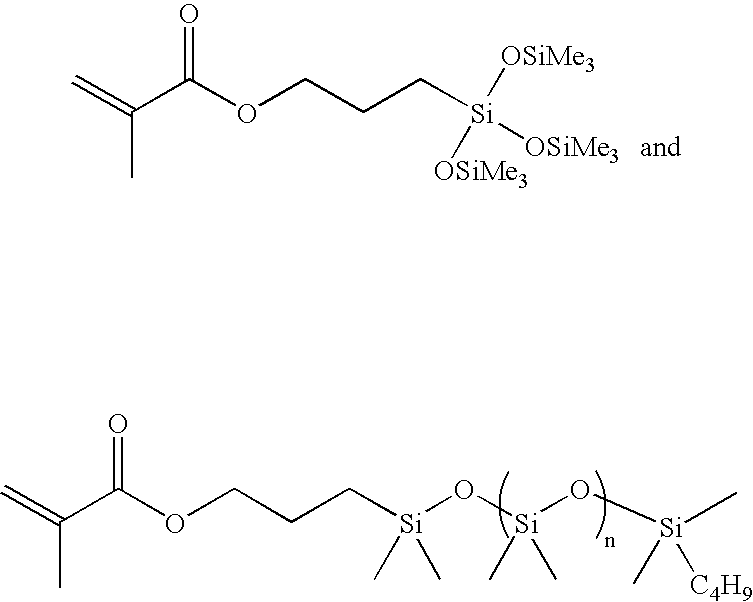Curable materials containing siloxane
a technology of siloxane and curing materials, which is applied in the field of materials containing siloxane, can solve the problems of b-staged materials being too tacky for successful storage, b-staged materials being prone to absorbing moisture, and adhesion or coating materials, etc., and achieves the reduction of voiding, high permeability, and tackiness.
- Summary
- Abstract
- Description
- Claims
- Application Information
AI Technical Summary
Benefits of technology
Problems solved by technology
Method used
Image
Examples
examples
[0041] Examples 1-10 describe the preparation of the polymeric material with the general structure of
example 2
describes the preparation of a comparison acrylic elastomer (i.e. when e=0%). Examples 4-6 describe the preparation of the polymer in various solvents. Examples 7-10 describe the preparation of the polymer with various molecular weight distributions. Examples 11-12 describe the preparation of the polymer with varying amounts of siloxane monomer (i.e. when e=5.0% and 2.5%). Examples 13-14 describe the preparation of the polymer with varying amounts of siloxane monomer (i.e when e=5.0% and 2.5%) and without ethyl acrylate (i.e. when b=0%). Examples 15-18 describe the preparation of the siloxane monomer with varying amounts of glycidyl methacrylate (i.e. when c=20%, 15%, 5%, and 2.5%) and without ethyl acrylate (i.e. when b=0%).
example 1
Preparation of Polymer and Physical Characteristics
[0042] A monomer mix of butyl acrylate (BA, 30 g), ethyl acrylate (EA, 30 g), glycidyl methacrylate (GMA, 10 g), acrylonitrile (AN, 20 g), 3-(tris(trimethylsilyloxy)silyl)-propyl methacrylate (TMPS, 10 g), and toluene (100 g) were charged into a 1 L four-neck round bottom flask equipped with a thermometer, condenser, overhead stirrer, addition funnel, and nitrogen inlet / outlet. The mixture was purged with nitrogen for 30 minutes, then 2,2′-azobis(2-methylpropionitrile) (AIBN, 0.020 g) as a free-radical initiator was charged into the flask, heated to 80° C. in an oil bath and held at that temperature for 20 hours. The toluene was then removed to give 44.9 g of neat polymer, which was then dissolved in 50 g of carbitol acetate. The mixture was then washed with three 200 mL portions of methanol and dried in a vacuum oven at 80° C. overnight to yield a colorless rubber (20.29 g).
[0043] Mw was determined to be 147,823 g / mol by GPC. Pol...
PUM
| Property | Measurement | Unit |
|---|---|---|
| temperature | aaaaa | aaaaa |
| temperatures | aaaaa | aaaaa |
| temperature | aaaaa | aaaaa |
Abstract
Description
Claims
Application Information
 Login to View More
Login to View More - R&D
- Intellectual Property
- Life Sciences
- Materials
- Tech Scout
- Unparalleled Data Quality
- Higher Quality Content
- 60% Fewer Hallucinations
Browse by: Latest US Patents, China's latest patents, Technical Efficacy Thesaurus, Application Domain, Technology Topic, Popular Technical Reports.
© 2025 PatSnap. All rights reserved.Legal|Privacy policy|Modern Slavery Act Transparency Statement|Sitemap|About US| Contact US: help@patsnap.com



